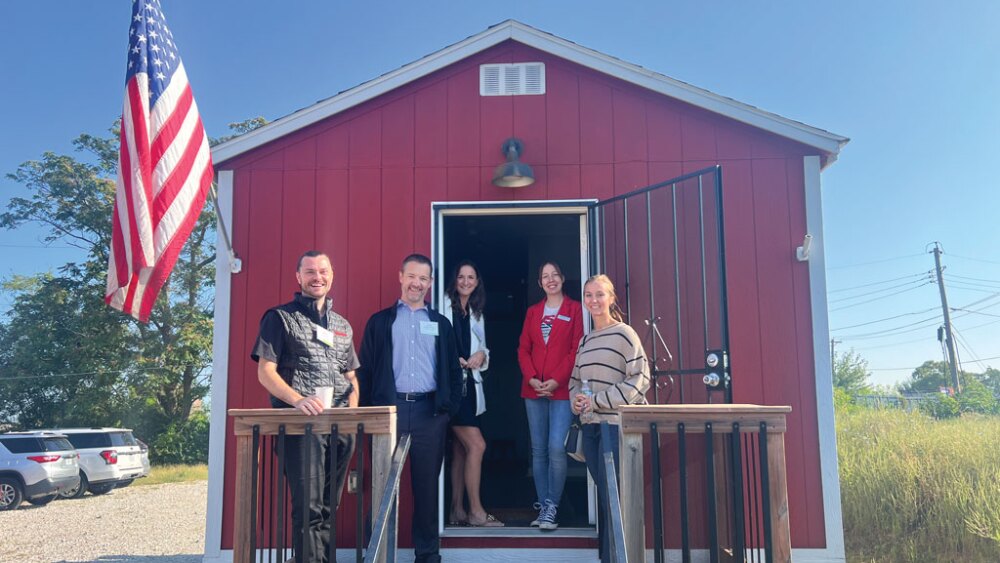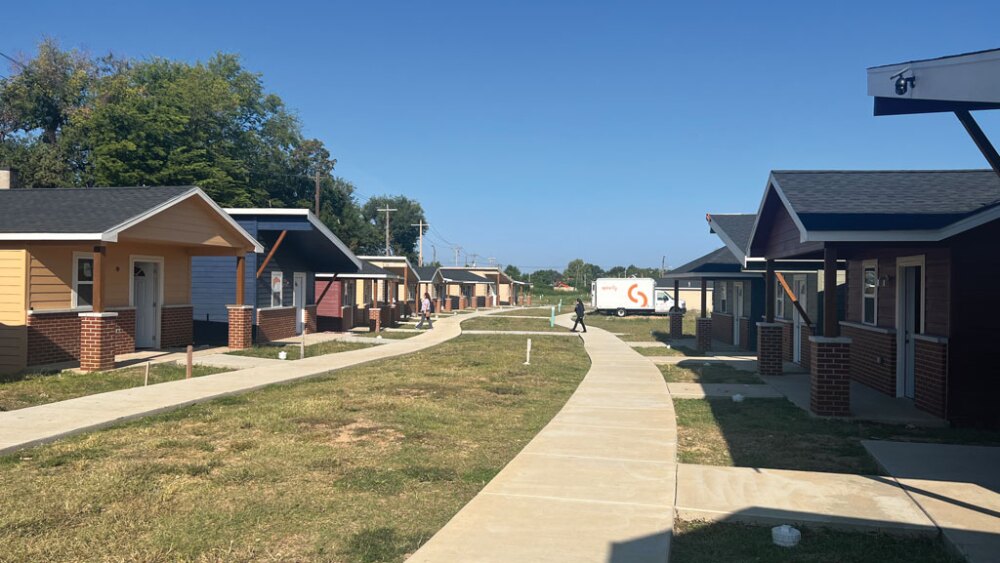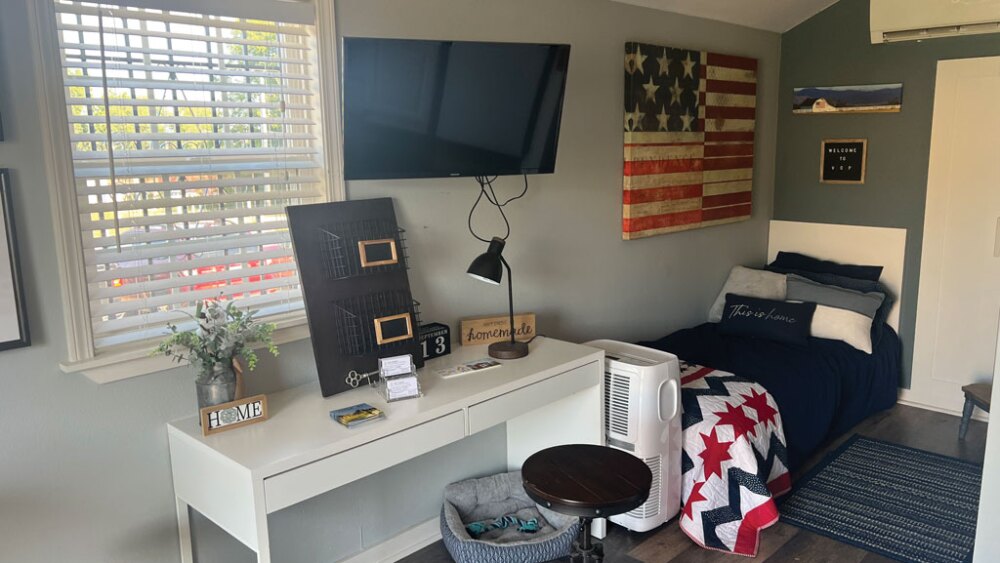America’s 36,000 homeless veterans, who constitute roughly 5 percent of the homeless population, deserve to move from homeless to housed as much as any affected group. Many homeless veterans have post-traumatic stress disorder (PTSD); and every day, 18 homeless veterans commit suicide. Most are not connected to any support services, indicating that homeless veterans need far better services.
Relatively few homeless veterans—ranging from 25 percent to 40 percent, depending upon the transitional housing facility—move from temporary housing to permanent housing.
Enter the Veterans Community Project, a charitable organization founded in 2016 by Bryan Meyer, Mark Solomon, and other combat veterans in Kansas City, Missouri, who were frustrated by the rampant homelessness and suicide among veterans. The Veterans Community Project serves any veteran who took the oath to defend the Constitution, regardless of discharge status, length of service, or branch of service. The program strikes an effective balance between community and individual dignity, employing a robust combination of housing and services. As a result, the program has a high success rate of 85 percent in transitioning unhoused veterans to permanent housing.
This effective program might be accelerated and spread nationwide by such creative land use techniques as Enhanced Use Leasing, which greatly reduces the time spent on land assemblage, environmental compliance, and infrastructure functionality.
Supportive community
Veterans, having lived alongside soldiers who perhaps even dodged enemy fire together during their service, tend toward a strong continuing need to live in a supportive veteran community. Responding to this need, the Veterans Community Project provides transitional housing in veteran villages of tiny houses and individual case management for residents.
To find new residents, VCP takes referrals from existing homeless service providers, meets veterans weekly through its walk-in program, and conducts public outreach to identify those who are currently living on the streets. VCP assesses and prioritizes potential residents based on their vulnerability to homelessness, with the most vulnerable receiving a higher priority.
Developing tiny house villages
At the threshold of developing villages for veterans lie three largely invisible yet costly challenges: land assemblage, environmental remediation, and infrastructure functionality.
Christie Brinkman, design-build director for Castle Consulting LLC and mission advancement chair for ULI St. Louis, explains: “Leveraging our civil design-build capabilities and relationships with the city of St. Louis and others, the Castle team was able to deliver a fast and cost-effective land assemblage, environmental remediation, and site infrastructure solution to the Veterans Community Project. It was a complex site, but knowing [that] every dollar saved goes toward serving our veterans encouraged the effort to collaborate and find creative solutions with all the agencies that had to approve the project.”
Another hurdle: St. Louis’ zoning code did not allow for tiny house villages, so the Veterans Community Project applied for a planned unit development (PUD) permit that did allow such villages—and got one. Each home is built on a concrete foundation, meets building code requirements for new construction, and connects to city sewer, water, and electric services.
Each tiny home is 240 square feet, or 360 square feet for family houses (22 sq m or 33 sq m, respectively), and features a bed, a small kitchen, and a bathroom. Much like a furnished studio apartment, the tiny house provides everything a veteran needs to live with dignity and safety: new furniture, appliances, housewares, bedding, and utilities, free of charge. All furniture and most appliances are donated. Veterans transitioning to permanent housing keep the furniture when they leave.
Beth Letscher, executive director of ULI St. Louis, says that “trauma-informed design” pervades the architecture of the tiny houses. Every detail of the tiny homes has been designed with combat veteran needs in mind. Each house has only one door and only one window. The layout is configured so veterans have their backs to the wall and can see both the door and window entrances, increasing the sense of security for residents affected by post-traumatic stress.
Beyond such ongoing effects of combat, the trauma-induced design of the tiny houses also addresses racial trauma, from which many minority village residents are likely to suffer. Unlike PTSD, which is linked to a particular experience, racial trauma is marked by continuous direct and indirect exposure to race-based stress. Symptoms include fatigue, lack of focus, hypervigilance, avoidance, headaches, and heart palpitations.
The Veterans Community Project’s goal is to get each veteran ready for permanent housing within two years.
Social services
Rebecca Tallman—retired from the United States Air Force and currently executive director of the Veterans Community Project in St. Louis—emphasizes that the foundation of the project’s social services program consists of five pillars: physical and mental health and well-being, income stability, fiscal responsibility, education and training, and network of support, which together produce a highly intensive process of service delivery. Caseworkers, each of whom is limited to advising 10 veterans, discover the root cause of each veteran’s homelessness through an on-site community center.
Each veteran meets weekly with a case manager to gain incremental, lasting results in areas of health and wellness, education, financial literacy, and the development of a personal support network. When the veteran is ready, the Veterans Community Project assists the veteran in securing permanent housing.
The project also strives to create community among all veterans by offering services for nonresident veterans through an outreach center, as well.
Philanthropic financing
Making everything at the Veterans Community Project available to veterans, free of charge, requires substantial philanthropy. The project is financed exclusively through private donations and nonrestrictive grants and thus does not accept federal funding.
The Veterans Community Project received $2.2 million from the Missouri Veterans Commission to build the tiny house village in St. Louis, as well as a $500,000
investment from the Veterans United Foundation. The project also has a partnership with the Boeing Company. With more than 2,000 military veterans employed by Boeing in the St. Louis area, the airplane and defense manufacturer provides to veterans essential workforce transition support, rehabilitation, and recovery programs that address visible wounds and invisible ones.
Enhanced Use Leasing
The Veterans Community Project has now completed—or is planning—tiny house villages for veterans in locations including Kansas City, Missouri (49 houses); Longmont, Colorado (26); St. Louis, Missouri (50); Sioux Falls, South Dakota (25); Milwaukee, Wisconsin (40); and Glendale, Arizona (50).
One secret to the project’s success is obtaining cheap land for its projects, often from sympathetic governments under political pressure to address homelessness.
The Veterans Community Project’s ambitious national rollout plans could be accelerated by using creative land acquisition techniques. To consider just one of several dozen such techniques, Enhanced Use Leasing (EUL), a kind of “barter leasing,” offers real promise here. Under EUL, the ground landlord of the land for the project (the government) does not receive money rent from the ground tenant (the developer) under the terms of a long-term ground lease. Rather, in lieu of money rent, the ground tenant builds an improvement valuable to the ground landlord that serves as in-kind rent in consideration for using the land. The EUL technique offers particularly high potential for veteran villages because it is common in government deals and may be used on surplus land of federal, state, or local governments—including land of the Department of Veterans Affairs itself.
The advantage of EUL to governments is that they may use their surplus land to promote important government policies, such as housing homeless veterans, with no upfront expenditure or issuance of bonds for debt finance. Through the “enhanced use” of the land by a ground tenant-developer, such as the Veterans Community Project, the government extracts more value from its land than by leaving it fallow and, thus, comes out ahead.
Furthermore, by ground leasing the land through EUL rather than selling it, a government agency such as the Department of Veterans Affairs (VA) is much more attracted to making deals with developers like the Veterans Community Project. The developer in effect land-banks the land for the government for its use in the long-term future, so that the government maintains permanent ownership and control of the land.
The advantage of EUL to developers such as VCP is that EUL releases more land to develop, often on relatively large VA campuses or other government parcels. The surplus land of the VA and other government agencies is relatively likely to be within urban areas. EUL thus enables a developer such as the Veterans Community Project to develop a larger number of tiny house villages in urban areas where most veterans are located and non-EUL land is prohibitively expensive.
Moreover, particularly on federal and state land, EUL substantially accelerates the project’s rollout of tiny house villages in urban areas by removing regulatory barriers. Because federal and state governments are superior sovereigns to local municipalities, development on federal or state land follows federal or state law, and generally preempts local municipal land use laws. Although negotiating an EUL lease is a bureaucratic task that does take time, it almost certainly takes less time than obtaining the dozens of local zoning, planning, and environmental permits ordinarily required from a municipality.
And finally, the advantage to veterans themselves of using EUL is that it enables a greater number of tiny house villages to be developed to transition more veterans more quickly into more permanent housing.
Tiny houses + Enhanced Use Leasing = housing many veterans
The combat veterans who devised and largely continue to lead the Veterans Community Project—in some cases formerly homeless veterans themselves—viscerally grasp the plight of homeless veterans, and they continue to act forcefully upon that understanding.
On the housing side, VCP provides trauma-informed design through tiny houses that strike a balance between community support and individual dignity, and that enables 85 percent of its village resident veterans to advance to permanent housing.
On the social support side, intensive-focused support services are what veterans need most to transition to permanent housing. In the end, it both pays and is more humane to provide those intensive services sooner rather than later.
Accelerating the development of veteran villages through Enhanced Use Leasing would accelerate the rollout of the promising Veterans Community Project homeless-to-housed model on a cost-effective national basis. Moreover, EUL can also save time on land assembly, compliance with local land use laws, environmental matters, and infrastructure.
The clear path that the Veterans Community Project establishes for each homeless veteran to be housed could, in microcosm, model a clear path for the entire United States. If each of the 50 states built 10 of these tiny home villages with 50 veterans, that’d be 25,000 veterans potentially served. Discounted for the 85 percent success rate, that’s 21,250 formerly homeless veterans saved from homelessness by transitioning to permanent housing.









